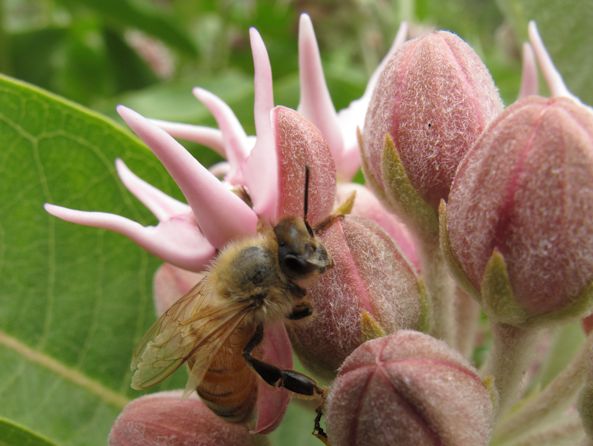Showy milkweed – common and extraordinary
Most residents of Eastern Washington are familiar with this plant, whether they know it or not. Often growing in rather bare areas or along roads, the tall plants with the large, leathery leaves stand out in the landscape, even more so when the big seed pods open and release their seed to the winds. It may fit some people’s idea of a weed, yet it is a native plant, and exceptional one at that.
Showy milkweed (Asclepias speciosa), Asclepias referring to the Greek god of medicine (powerful medicine was attributed to this plant, and it does contain toxic glucosides) and speciosa is Latin for showy. The flowers are amazingly intricate (and fragrant! When the big patch in the nursery is in bloom the perfume is a delight). The unusual flower structure ushers visiting bees to the nectar they seek and in the process attaches a pair of “saddle-bags” (pollinia) containing pollen to the bees’ feet, ready to land on the stigma of the next flower they visit. I’ve seen a half-dozen different bee species on my milkweed. I think anyone who wants to create or improve pollinator habitat has to have a milkweed patch, and a patch it will be as the plant has strong rhizomes that extend out from the mother plant.
You may also know how closely associated milkweeds are with the Monarch butterfly. This iconic insect lays its eggs only on milkweed, and the larvae, feeding on the plant, incorporate its toxins into their bodies. Not only does this make the larvae bitter and toxic to predators like birds but the adults retain this repulsive attribute from the milkweed. I have never seen a Monarch but this may the year to find them. Dr. David James, a WSU entomologist who recently authored, with David Nunnalee, THE book on our butterflies (“Life Histories of Cascadia Butterflies”, //osupress.oregonstate.edu/book/life-histories-of-cascadia-butterflies), reports that overwintering populations of Monarchs in California were the highest in a decade so we should find more than usual in Washington. Check those milkweed patches for the distinctive larvae with black, yellow and white bands.




